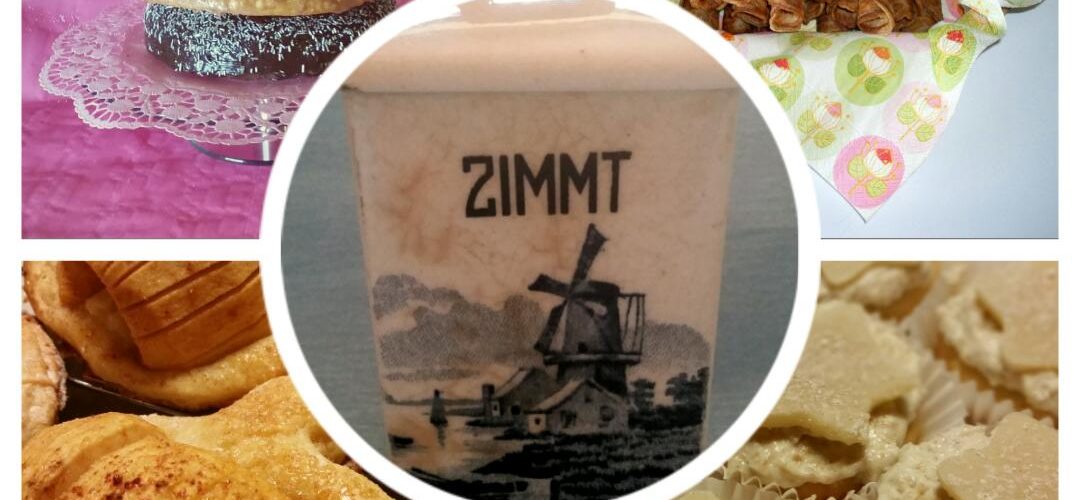Cinnamon was always plentiful at Oma’s.
Everybody’s got this one scent or flavour that evokes childhood memories. Mine is cinnamon. “Zimt”, as we say in German, or “Zimmet”, as my grandmother would pronounce it going with the sing-song of Moselle-Frankonian dialects, which insert vowels as deliberately as you’d expect from a heavy Italian accent.
Oma’d stir it into apple sauce and rice pudding, blend it in when making crumbs, use it in glaze and in her famous cinnamon wafers. When we cleared out the kitchen after her death, there still were large supplies of cinnamon she’d bought when she already couldn’t handle doing the cooking by herself anymore. To me, it couldn’t have been more precious and more characteristic of her caring self.
As someone who got an electric hotplate at age four as she kept complaining that the toy stove was not working, I strongly relate to the binding and memory-building qualities of cooking and baking.
Memories are of little use if they don’t get shared, so here are two of Oma’s quick fixes using cinnamon that you can use to add a nice touch to your baked goods or – if you aren’t into baking – improve store-bought pastries.
Cinnamon glaze
It doesn’t get much easier.
You’ll need:
icing sugar (about 250gr for coating an entire, large loaf cake)
cinnamon
hot water
Sugar is hygroscopic; that means it “attracts” water also from ambient humidity.* That’s why icing sugar in an open package often lumps together. To avoid any lumps in the glaze, sift the icing sugar. Mix with a generous amount of ground cinnamon. Stir in a little hot water at a time until you get the desired consistency.
For pastries that are already hot, a thinner icing applied immediately will give you a crispy, translucent glaze. As the water quickly evaporates due to the heat, the glaze dries within seconds.
That version is great to seal in moisture in pound cakes, especially ones prepared ahead of time. In the above image, you can see it used on the donut cake**. It also works great on danishes and yeast-based breads like challah to add a touch of spicy sweetness.
For pastries that have already cooled, a thinner icing will work like a syrup. If you want a glaze, add less water and give the icing time to set. This is my favourite on a hazelnut loaf cake. Substitute 100gr of flour by 200gr of toasted ground hazelnuts in your favourite, plain loaf cake recipe.
Cinnamon Crumbs
Beyond the crumble cake: if you bake the crumbs on a baking tray, plucking them apart with a fork before they cool and firm up, you can use them as sprinkles on ice cream or as a homemade component in layered desserts that call for cookies.
If you prepare a larger quantity (say 500gr of flour) of the crumb base, you can cover the base of a prepared 11″-tarte pan or springform pan, press them down and form a rim, top with your favourite pie filling (cherry, thick apple sauce, fresh apples, or fresh, pitted cherries etc.), and distribute the remaining crumbs on top of that. Bake at 180°C for about 25 minutes. The crumbs will firm up as the pie cools. Time invested: under ten minutes. No kidding.


For Oma’s cinnamon crumbs, you’ll need:
2 quantities (weight) flour
1 quantity butter (margarine will work, too, but not be as rich)
1 quantity sugar
vanilla
a generous amount of ground cinnamon
a pinch of salt
Combine the ingredients in a bowl by hand, fork, or a handheld mixer (the sugar need not dissolve!). Use your hands or a fork to pluck into crumbs.
To make crumbs for sprinkles, spread them onto a lined baking tray, bake them for ten minutes at 180°C, remove from the oven, and pluck them apart with a fork before they firm up.
*SprinkleBakes gave me the idea of trying my hand at a donut cake. While she created a beautiful, vibrant version, I chose to go with my favourite flavours in Entenmann’s as we don’t have Entenmann’s in Germany.
**Use the hygroscopic qualities of sugar to your advantage when you’re storing cookies or pastry shells. Cookies and pastry shells at some-too-soon point take on a stale taste or a different texture. To prevent that from happening, put a sachet of vanilla sugar (or a tea filter filled with 2 tbsps of sugar or vanilla sugar if you cannot get hands onto those sachets) at the bottom of your cookie jars or other pastry containers. Put a layer of baking parchment on top of the sugar sachet before you fill the cookies into the container.
You can also use vanilla sugar sachets to keep hardly used coffee pots from getting a stuffy smell when sitting in the cupboard for a longer time. If you’ve got “the good china”, you can relate.
P.S.: The spice box in the image above is my great-grandmother’s, and yes, it does date back to a time when the spelling required two Ms.





